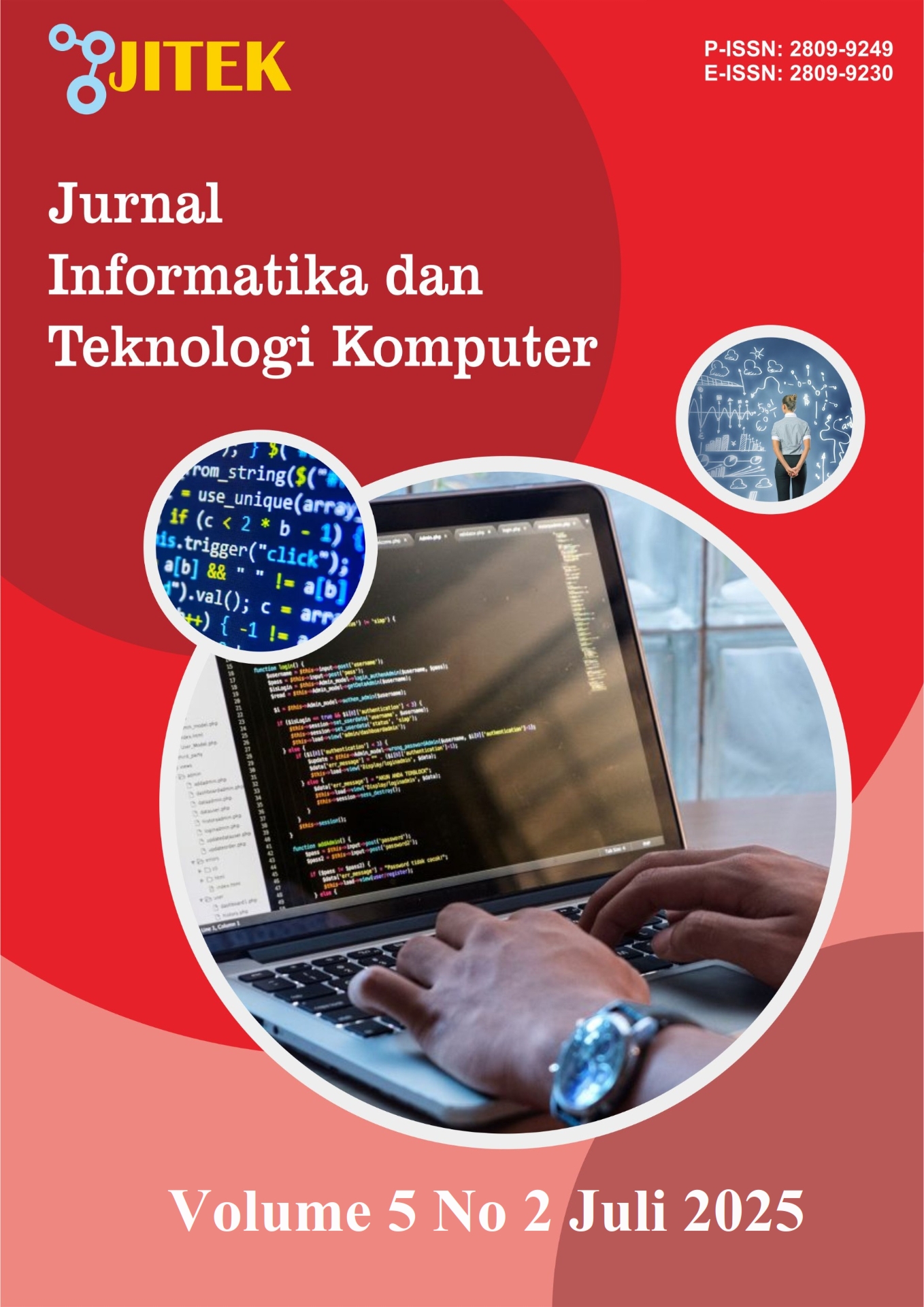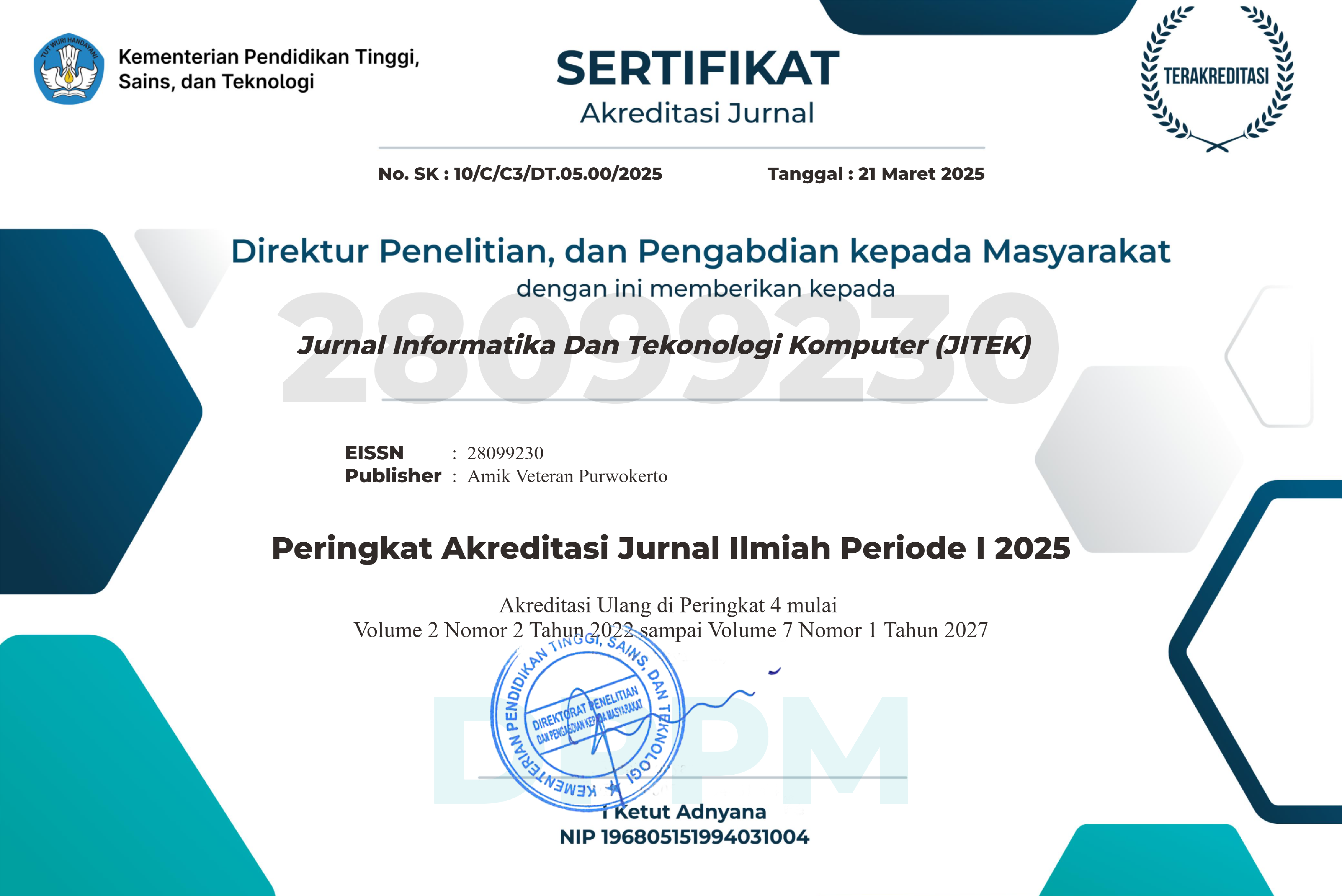Sistem Cerdas Pemantauan Kualitas Air dan Pembersihan Otomatis Berbasis IoT dengan Turbidity Sensor Menggunakan GPRS SIM900A Berbasis Android.
DOI:
https://doi.org/10.55606/jitek.v5i2.6061Keywords:
IoT, pemantauan kualitas air, sensor kekeruhan, SIM900A, ArduinoAbstract
Water quality is a crucial factor in supporting life, especially in water storage systems used for domestic and industrial purposes. A common issue that arises is the degradation of water quality due to increased turbidity, which can pose health risks and reduce water utilization efficiency. This study aims to design and develop an intelligent Internet of Things (IoT)-based system capable of real-time water quality monitoring and automatic cleaning of water storage tanks when turbidity exceeds a predefined threshold. The system utilizes a turbidity sensor to detect water clarity levels, a SIM900A GPRS module for data communication, and an Android application for real-time data visualization to the user. Monitoring and cleaning processes are controlled by an Arduino microcontroller integrated with an SMS-based alert system and a mobile user interface. Test results show that the system accurately detects turbidity levels, transmits data in real-time to the Android app, and automatically activates the cleaning mechanism when necessary. Additionally, the system can send early warning notifications via text messages. Therefore, this system offers an effective and efficient solution for maintaining water quality in a sustainable manner and contributes to the application of IoT technologies in smart water resource management.
References
[1] World Health Organization, Guidelines for Drinking-Water Quality, 4th ed., Geneva: WHO, 2022.
[2] S. Sharma, A. Kumar, and M. Patel, “Turbidity detection system for water quality monitoring using IoT,” in Proc. IEEE Int. Conf. Smart Environ. Emerg. Technol., 2021, pp. 56–60.
[3] S. Kumar and R. Singh, “IoT-based smart water quality monitoring system using cloud computing,” IEEE Access, vol. 8, pp. 134190–134202, 2020.
[4] H. Lee et al., “IoT-enabled real-time water quality monitoring system,” IEEE Internet Things J., vol. 7, no. 4, pp. 3364–3371, Apr. 2020.
[5] M. A. Khan and F. A. Shaikh, “Design and implementation of smart water quality monitoring using Arduino and sensors,” in Proc. IEEE Int. Conf. Comput. Commun. Technol., 2022, pp. 205–210.
[6] R. Verma and D. Joshi, “IoT-based solution for water pollution monitoring using turbidity sensor,” IEEE Sens. J., vol. 21, no. 5, pp. 6293–6300, Mar. 2021.
[7] J. Park and H. Kim, “Comparison of LoRa and GSM for IoT-based environmental monitoring,” in Proc. IEEE Int. Conf. Green Comput. Commun., 2020, pp. 44–49.
[8] T. Nguyen et al., “Limitations and optimizations of LoRa-based water quality monitoring,” IEEE Trans. Ind. Informat., vol. 17, no. 6, pp. 3808–3817, Jun. 2021.
[9] N. Ahmad, “Remote monitoring of water turbidity using GSM module and sensors,” in Proc. IEEE Int. Conf. Adv. Comput. Appl., 2020, pp. 120–125.
[10] F. Rahman and A. Hussain, “Smart GSM-based water quality monitoring for rural areas,” IEEE Commun. Lett., vol. 25, no. 3, pp. 1344–1348, Mar. 2021.
[11] R. S. Pandey et al., “Android-based application for IoT smart home integration,” IEEE Access, vol. 9, pp. 34567–34575, 2021.
[12] M. Chen, “Automation in IoT-based water quality systems: A review,” IEEE Rev. Biomed. Eng., vol. 14, pp. 123–132, 2020.
[13] A. L. Al-Fuqaha, M. Guizani, M. Mohammadi, M. Aledhari, and M. Ayyash, “Internet of Things: A Survey on Enabling Technologies, Protocols, and Applications,” IEEE Commun. Surv. Tutor., vol. 17, no. 4, pp. 2347–2376, 2015.
[14] H. Ghayvat et al., “Smart Water Quality Monitoring System in IoT Environment,” in Proc. IEEE Smart Cities Symp., 2021, pp. 112–117.
[15] J. M. Ott and T. R. O’Connor, “Design and Development of a Turbidity Sensor for Water Monitoring Applications,” IEEE Trans. Instrum. Meas., vol. 69, no. 4, pp. 1241–1249, Apr. 2020.
[16] M. R. Islam et al., “Implementation of Low-Cost Turbidity Monitoring System Using Optical Sensor,” in Proc. IEEE Int. Conf. Green Energy Syst., 2020, pp. 215–220.
[17] S. F. Wani and R. Kumar, “Real-Time Data Transmission Using SIM900A Module in Remote Monitoring Systems,” in Proc. IEEE Conf. Wireless Technol., 2020, pp. 88–92.
[18] A. Hussain and M. A. Khan, “GSM-Based Water Quality Monitoring and Alert System,” IEEE Access, vol. 9, pp. 17402–17410, 2021.
[19] D. K. Saini and P. K. Roy, “Microcontroller-Based Automation Systems Using Arduino,” in Proc. IEEE Automat. Control Conf., 2020, pp. 134–139.
[20] M. A. R. Sarkar, “Low-Power Embedded System Design with Arduino for Environmental Monitoring,” IEEE Sens. J., vol. 21, no. 10, pp. 11345–11353, May 2021.
[21] K. Patel et al., “Android-Based IoT Device Control and Monitoring System,” in Proc. IEEE Mobile Appl. Conf., 2021, pp. 67–72.
[22] F. M. Noor et al., “Design of Smart Monitoring App for Environmental Sensors,” IEEE Trans. Mobile Comput., vol. 20, no. 8, pp. 2455–2464, Aug. 2021.
[23] T. W. Hsiao and K. W. Lee, “Self-Cleaning Water Tanks Using IoT-Enabled Actuation System,” in Proc. IEEE Innov. Smart Cities, 2022, pp. 91–96.
[24] M. Hassan et al., “Design and Analysis of IoT-Based Automated Water Tank Cleaning Mechanism,” IEEE Trans. Smart Syst., vol. 11, no. 3, pp. 119–128, 2023.
Downloads
Published
How to Cite
Issue
Section
License
Copyright (c) 2025 Jurnal Informatika Dan Tekonologi Komputer (JITEK)

This work is licensed under a Creative Commons Attribution-ShareAlike 4.0 International License.








